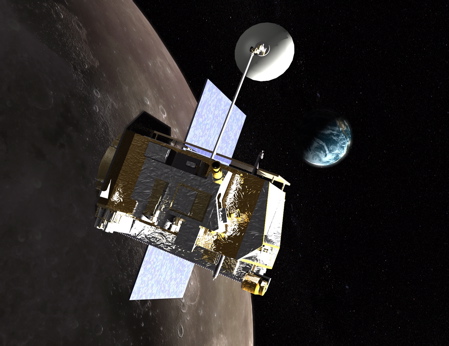
The Lyman-Alpha Mapping Project instrument (LAMP) is one of six instruments that resides on the Lunar Reconaissance Orbiter (LRO). LRO is the first step in NASA's plan to explore the Moon and ultimately return human beings to it. LRO's two main objectives are:
- To obtain maps of the surface reflectance in the permanently shadowed polar regions of the Moon.
- To map and determine the concentration of water ice in any exposed deposits of ice near the surface in these cold polar areas.
Each of the instruments on LRO has goals that, taken together, are helping scientists achieve those mission-level goals. LAMP has the following specific objectives:
- To create maps showing concentrations of exposed surface frost in the lunar polar regions. No such maps previously exist.
- To create maps of the landforms at polar regions, especially for the areas where such images have in the past been difficult to obtain because they never see sunlight or earthshine. Again, no such maps previously exist.
- To create maps of the lunar surface at night in order to demonstrate that such maps can be made without sunlight or earthshine.
- To search for, detect and monitor over time the abundance and variability of various kinds of atoms in the lunar atmosphere. Scientists expect LAMP will be able to accomplish this with 10 times more precision than previous studies have achieved.
The other instruments that traveled with LAMP on the Lunar Reconaissance Orbiter are: CRaTER (Cosmic Ray Telescope for the Effects of Radiation); Diviner; LEND (Lunar Exploration Neutron Detector); LOLA (Lunar Orbiter Laser Altimeter); and LROC (Lunar Reconaissance Orbiter Camera); The Mini RF instrument also acheived its technical demonstration.
Potential Challenges
The researchers working on LAMP are confident its goals are achievable. But that doesn't mean there aren't some challenges to overcome.
Observations by an earlier mission, the Lunar Prospector (LP), detected absorption of naturally occurring neutrons by hydrogen atoms. One possibility is that these hydrogen atoms are located near the Moon's surface in water ice. Theoretical predictions of the supply and loss of water ice to the permanently shadowed regions generally agree with this scenario and the water ice abundances estimated from the neutron measurements. However, the excess of hydrogen could also be in the form of free hydrogen or in molecules other than water that contain hydrogen. Therefore a primary objective of LRO is to determine whether the possibility of water ice is indeed true. Other independent observational methods are needed to clarify this. This is where LAMP observations come in to the story.
Scientists still need better laboratory measurements of the reflectance of water ice at "far-UV" wavelengths than currently exist (the only set of previous lab measurements were made during the Apollo era). LAMP scientists are currently conducting their own laboratory experiment to provide the best knowledge about the "far-UV" reflectance of water ice ever obtained. These results will have broad applications to "far-UV" observations of all sorts of solar system objects in addition to the LAMP Moon observations. Rather than being daunted by the challenge, LAMP scientists are embracing it and anticipating LAMP's observations.
Return to the top of the page.


